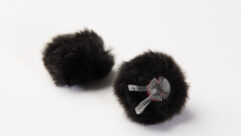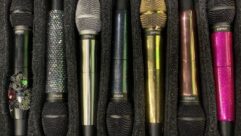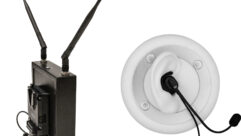

Designed for hands-free operation, headset microphones—with or without a built-in, in-ear monitor—have become quite popular beyond their original most common applications. From mundane cubicle jobs to glamorous stage work, wearing a microphone on your head provides significant benefits over using microphones attached to stands, podiums or clothing—or, of course, employing handheld models. Most importantly, a headset microphone’s diaphragm will remain a precise distance from its sound source (the user’s mouth) at all times; a turn of the head or even a gymnastic cartwheel won’t change that, thus headset microphone input will always be the most consistent signal possible in vocal tonality, timbre and volume.
DPA Microphones’ d:fine Headset Microphone Series is, for many reasons, the best I have found on the marketplace for no-compromise vocal transduction, whether spoken or sung, male or female, amateur or world-class sources. The unit I was provided for review from DPA— the d:fine Directional Headset Mic—comes in a variety of forms and skin-matching (or at least complimentary) colors; adapters abound for connectivity to a variety of wireless manufacturers’ products; and single- or dual-ear models are available.
Though omnidirectional and directional models are available, I chose the d:fine directional model in beige with DPA’s MicroDot connector, the latter of which allows the ultimate in connective flexibility. AKG, Audio Ltd., Audio-Technica, beyerdynamic, Electro-Voice, Lectrosonics, Line 6, MIPRO, Sabine, Samson, Sennheiser, Shure, Sony, Telex, Wisycom, Zaxcom and other wireless systems are easily connected to a d:fine headset via DPA’s extensive adapter collection, all available at additional cost.
Other than a slight, long and gradual rise between 1 kHz and 20 kHz from 0 dB/flat to +4 dB, the d:fine’s directional model is highly accurate, natural-sounding and flattering; d:fine’s omnidirectional model is razor-flat except for a 6-20 kHz bump to +4 dB maximum, though it loses the background noise rejection and higher comparative separation offered by the directional model.
What really separates DPA from its competition, especially in the realm of headset microphones, lies in design and materials. The d:fine headset is incredibly comfortable—a near requirement considering its quality and cost, meaning that it will end up on the heads of the most discriminating, talented and in-demand users. That said, it is equally at home in houses-of-worship (HOW) and theaters populated by amateur and burgeoning users; it is intuitive to wear and adjust and well-made, poised to stand up to the rigors of multi-user performance work.
Visually, d:fine can hardly be seen at a distance when well matched by skin tone and mic model color. That said, the black d:fine omnidirectional is so small, it would be a logical purchase for HOWs and theaters that can’t afford to buy multiple models but need a top-quality headset microphone.
In this review, I brought the d:fine to several locations—a house-ofworship with a wandering pastor; a community theater with a mishmash of wireless systems; and a school where the principal and various volunteers made announcements each morning from a wired input. In every instance, its users commented on how the d:fine was hardly noticeable once it was on and how comfortable the rubberized mount was around the back of the ear. It stayed in place, no matter the amount of user movement. And best of all, even microphone-apprehensive users were captured consistently and clear; hand a microphone to the same group of users, or stand them in front of a spot or a podium, and I guarantee the results won’t be that consistent or nearly as usable.
Is d:fine an affordable headset microphone? No, at least compared to other options on the market. But as I said, it’s incredibly well made and designed, all backed by DPA warranty and proven service, and so it’s a great investment built to last for years and years.










